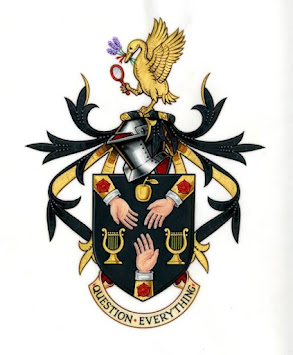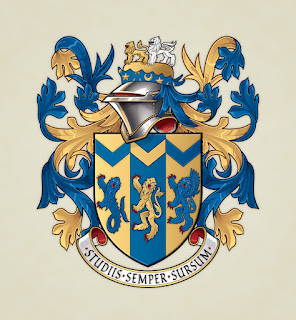My Grant of Arms by Heston Blumenthal OBE
My Grant of Arms
By Heston Blumenthal OBE
I didn’t petition the College of Arms for a grant of arms. I had no idea that was possible and, even if I had, I would never have imagined that I might be a candidate. My restaurant The Fat Duck gained three Michelin stars in 2004 and two years later I was awarded an OBE. I think it was on the back of that that the College of Arms sent me a letter in 2006 saying I was eligible.
It was a huge honour to be invited to become part of a tradition that extends back centuries, and that represents a deep-seated body of shared beliefs. It was also a deeply emotional experience, not least because I had by that point become fascinated by history – particularly British gastronomic history – and was often to be found in libraries, white-gloved, poring over recipes dating back as far as the 14th-century cookbook of Richard II’s chefs.
I first met the Officer of Arms Timothy Duke, who at the time was Chester Herald, and was to be my agent in guiding me through the process. We met at my other restaurant in Bray, The Hinds Head, which was a very appropriate place because it dates to the 15th century and is steeped in tradition: the late Duke of Edinburgh chose it as the venue for his stag party, and in 1963 Queen Elizabeth II hosted a tea party there.
From then on, Timothy and I met a number of times, either at The Hinds Head or at the College of Arms, in order to discuss what might feature on my coat of arms. However, I’m not sure Timothy realised what he was letting himself in for. A coat of arms is very public and very permanent, and I wanted everything to be perfect and fully capture my beliefs and history in the design of my arms – so it took seven years to figure out! Sometimes I’d make suggestions to Timothy only to be met with the discreet and diplomatic reply: “Heraldry doesn’t favour that.”
In the end, I decided that each charge needed to refer to one of the senses – such as the Lyre for sound – because that’s a formative part of the eating experience; and engaging all the senses is a key feature of how I create dishes. However, most of the charges have other allusions too. The apple signifies not only taste but also close observation and creative, non-linear thinking (via Newton’s supposedly apple-inspired discovery of gravity). It stands, then, for scientific enquiry and a scientific tradition that extends from Newton’s Royal Society to the Royal Society of Chemistry, of which I am an Honorary Fellow. It’s a reminder that we need always to look deeply and push towards discovery. The Magnifying Glass represents sight but also investigation, awareness, curiosity and exploration – all of which seem to me key features of human imagination and interaction.
The Hands Outstretched represent touch and human connectivity. The three roses work on two levels. Traditional emblems of England, these flowers reflect my interest in reviving and reintroducing historical British dishes like Meat Fruit, Quaking Pudding and Beef Royal. But they also allude to my restaurant’s three Michelin stars – another historical tradition I’m proud to be a part of. Lavender signifies smell but serves, too, as a reminder of the garden of L’Oustau de Baumanière, the French restaurant that inspired me to become a chef in the first place. This in turn emphasises the importance to me – and my cooking – of memory and nostalgia and how we draw on the past to spring into the future.
Perhaps the two most important symbols are at the crest and the motto. Above the helm is a duck, which refers to my restaurant, The Fat Duck. The bird is caught in a moment of flux – either landing or taking off – which represents change and evolution and new perspectives and potential. And on the scroll is my motto: Question Everything, which accurately encapsulates my worldview and the way I approach cuisine and gain insight and inspiration.
In addition to my coat of arms I was granted a badge, which was, I think, traditionally used to advertise allegiance. For mine I chose a question mark. (I’m not sure if I’m the first person who has this symbol, or indeed the only person now allowed this symbol as their badge.) The question mark reinforces of course my motto. Its twisted strands of rope allude to string theory and thus the scientific imagination, as does the apple, again emphasising Newton and all he stands for. And, if you spin a question mark (which I’ve done using animation) it looks like a lightbulb. The lightbulb moment!
If you’d like to learn more about heraldry, you can join The Heraldry Society today, or gift someone close or yourself a membership for Christmas! More details are available at www.theheraldrysociety.com












Great, thanks for sharing! Love his food documentaries.
ReplyDelete